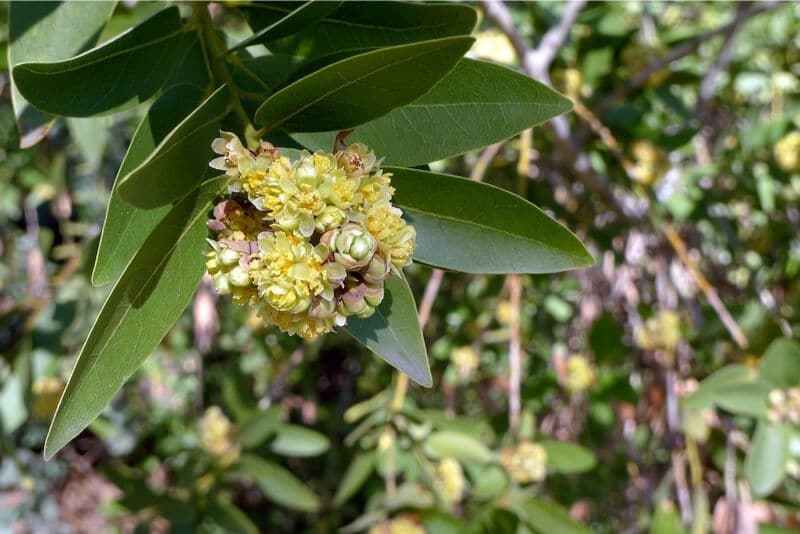An Introduction to Wild Bay leaf
Umbellularia californica or Wild Bay Leaf as it’s called is another Native American plant/tree indigenous to the state of Oregon and likewise also California. It goes by many names, from California Bay to Cinnamon bush to headache or even peppernut tree. It has various unusual properties that set it apart from other plants in the region that range from a strange smell from its leaves to others that will be explained later on. This plant isn’t the same as the Common Bay Leaf plant and is very different although people confuse the both for one another.
Places where you can spot Wild Bay leaf:
You can find it mostly in forests inhabited by red wood trees, oaks or pines and forests near the coast. They prefer wet areas and thus forests that have a good amount of moisture are the go to places to go looking for Wild Bay Leaf. All of these places to find this Native American Plant of course should be in California.

Physical Appearance:
The plant has a green coloration spread though out its whole structure. It can reach a height of 98 feet with a trunk breadth upwards of 31 inches. Some specimens have been reported to be even taller than a 100 feet and the area they occupy is even more. They have yellow flowers but some may have a bit of green. The flowers grow in small bunches and have both genders present at the same time in each flower.
They also have fruits that are berry like and are called California bay nuts. The fruit itself appears green with some spots of yellow here and there. The fruit may also have a purple coloration when it starts developing. Speaking about fruits, the time for the fruit to ripen is from October to November but may vary in other places. A bit more this amazing tree is that it can live for close to 400 years or more.
Distribution and importance of this Native American Plant:
It is quite commonly find in parts of Oregon from the north or the southwest. You can discover it in mountain range of the Sierra Nevada Mountains as well and some specimens have also been found in Washington. Other examples of the plants widespread presence have also been seen in British Columbia as well.
It is preferred by musical instrument makes due to it being a good tone wood. Wild Bay Leaf may however carry a deadly pathogen that kills off surrounding oak specimens. Detergents have also been made from this plant. Various oils have also been prepared by adding Wild Bay Leaf because of its aromatic nature. The wood may have also been used to make Bows by the natives.
The role of Wild Bay Leaf in Cooking:
If we go back in history we can see that it Wild Bay Leaf was also considered a key food item as well. Native American people found the fruit edible after a ripening period during which it loses all of the strong scent it may have. They mostly dried the fruit to be eaten later or whenever they found it convenient. The pit or big seed of the fruit was even roasted due to its chocolate like flavor and was processed into powder. The powder would later be used for cooking.
The leaf of the plant can be used in a similar way to a common bay leaf but it is stronger and should be used in lesser quantities. The flavor of the leaf has some cinnamon type flavor and can be used in various kinds of stews, soups or even teas.
The nuts when roasted can also be used to make drinks similar to a good cup of coffee.
The Medicinal Uses of Wild Bay Leaf:
Long ago Native Americans came to realize the importance of the Wild Bay Leaf tree. A specific paste was even made to treat various skin ailments. The leaves were also soaked or simmered in hot water to make a dressing to treat infections. Another important medicinal preparation they made was tea. The tea itself like other teas was used to treat coughs, flues, colds and other symptoms that similar sicknesses bring. Wild Bay Leaf was also used by some native tribes to treat conditions like headaches as well. Bowel conditions such as gastroenteritis were also treated through its use. In short this plant/tree has its fair share of wonder but we have yet to discover its true potential.
To Learn about Common Bay Leaf please check out:
https://eattheplanet.org/bay-leaf-victorious-wreaths-and-rich-flavoring/
Science direct has an interesting paper on Wild Bay Leaf or California Bay, If you are interested go to:
https://www.sciencedirect.com/topics/agricultural-and-biological-sciences/umbellularia-californica
—————————————————————————————————————-
| Written By Muhammad Waleed Raja,
~ Waleed is an avid graphic designer, animator, illustrator as well as freelance writer with an affinity towards nature, art, technology and everything that encompasses gaming along with pop-culture added into the mix. To learn more about him look up his profile on upwork.com ~
—————————————————————————————————————-






